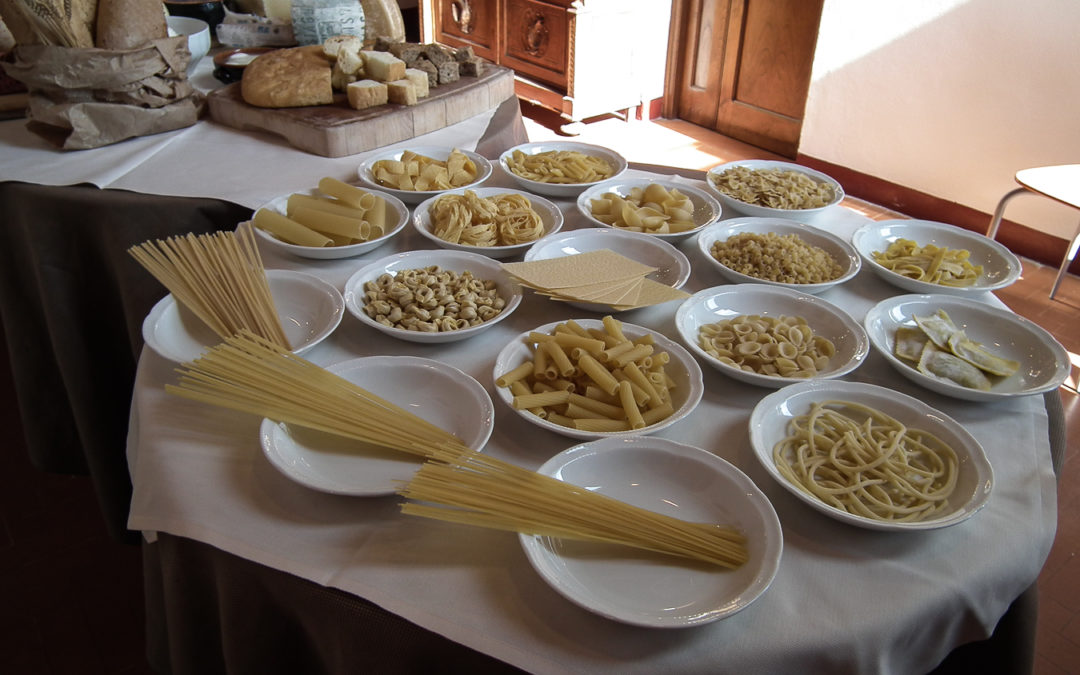In the spring of 2013, Henderson Productions was proud to travel with the experts from the restaurant chain, Olive Garden to explore as much about food and Tuscan life as possible. We’ve created this series of blogs which, like the region, should remain relatively timeless. Bon Apetito.
Our agenda today is meant to be cooking lessons in the morning, a grazing/picnic lunch – described as a little bit of this and that by Paolo – and then a trip into Sienna for free time and a big dinner. Food. I am praying the weather stays nice enough for us to walk a BUNCH of this off in Sienna, Florence and Rome later in the week. There are not enough stairs or distance between our apartment and the kitchen in our little Tuscan hillside!
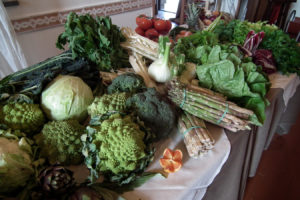
Typical Tuscan vegetables
We had slept well and I had been up before the sun came lollygagging over the olive trees as if it were a cat waking up and stretching. Breakfast was available from 8 AM and we had a 9:30 call for our first lesson. Chef Paolo has a lesson plan he uses with all the employee groups and he gave us the same for almost 2 hours. This is just glancing the highlights! “Italian food is endless….’cause the Roman empire set us up by looking at so many cultures” And another quote: “The Romans were party animals. They were all about food and drink and developed every possibility.”
He had a running joke about how much French food is dependent on what the Romans brought to them including champagne, wine and all their sauces. When the Roman empire split up, everyone came back to their little hillsides and brought their favorite elements with them. Hence the various Italian regions developed different ingredients and skills. During the middle ages, all these tastes were assimilated into local cooking with little or no exposure to other fiefdoms making them still distinctive.
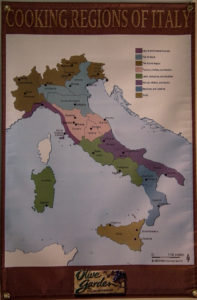
Map of the Italian Food Regions
Each region has different soil and sun exposure, and grapes are planted specifically for those conditions making multiple wine possibilities.
Liguria – pesto and Genovese Vermentio wine.
Northern Alpine – fontina cheese, fonduta, chocolate, white truffles, osso bucco, risotto Milanese (with saffron), apples, chestnuts, San Danieli prosciutto (unique because the pigs eat chestnuts and the flavor is evident) and Tocai wine.
Veneto – Venetians brought coffee to Italy from Turkey, tiramisu, spaghetti w lobster, Ameroni wine, rice growing region, and Bologna invented egg noodles – lasagna, ravioli, etc., mortadella, parmesana-reggiano, and Modena invented balsamic vinegar.
Tuscany/Umbria – Peruggiana chocolates, steak Fiorentina, biscotti, bread soups, Papa de Pomodoro (tomato marinara soup), Brunello and Chianti Classico wines.
Rome/Campagna/Sardinia – pecorino Romano, chicken shrimp carbonara, lots of pork dishes, putanesca, frescati wines, Napoli pizza, 1st place to use tomato as a food in the 1800’s after it had arrived from the new world, mozzarella – water buffalo milk, burrata, and Greco di Tuffo wine which grows best in pumice rock.
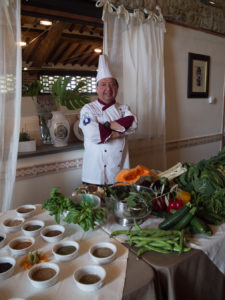
Chef Paulo and the teaching table
Abruzzi/Pulia – great cheeses, home of zinfandel grapes, the “table of Italy”, 5 million olive trees
Calabria – peperoncino (red chili) and sweet eggplant
Sicily – citrus, wines from Etna, veggies, watermelon, pecorino siciliana, gelato, canola, pistachio
As if the information alone wasn’t worth the trip, we then proceeded into what he called the Italian market – staff had set up a long table of pasta shapes, cheeses, salamis, spices and vegetables and Paolo and Aldo (head chef at Fizzano) walked us through a dazzling display of choices and their importance. Aldo tells us the kings of the kitchen are celery/carrot/onions. And there are “black, blond and red (pepper) which equal sweet, hot and regular flavor”. Every kitchen has a finely chopped mix of these three called a bottuto in the refrigerator (2 sm onions/1 carrot/1 celery stalk). As soon as bottuto touches hot oil it becomes sofrito and the base of sauces, soups, etc.
Radicchio looks like red cabbage. They only use sea salt for cooking – there are no salt mines in the country and an abundance of sea salt. Salad greens can be eaten cold as we do or wilted in sea salt and a little oil as a side dish. Fennel is good for digestion.
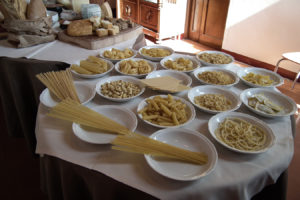
Pasta types and styles
Broccoli is good pairing with pork. Tuscan black kale – very tasty – clean, chop and boil to add to everything from crustini to soup or risotto. Roman cauliflower is bright green. Chicory – boil leaves for a side dish. Risotto with pumpkin- more like a butternut squash or use the smallest pumpkins in the US. Cooked, mashed pumpkin added to smashed amaretto cookies and a little olive oil makes his favorite ravioli stuffing!
Cook mushrooms with garlic. If the garlic turns blue color, the mushrooms are poisonous. Who knew?!

Mushroom options abound in Tuscany
Eggplant, bell pepper and zucchini are found in every kitchen year-round as the basis of all dishes and because they can do anything. (Hmmm – how many essential trios are there?)
Fava beans in season are tender and used like peas as well as eaten raw. Once they get bigger, they are best dried for off season use. Capers are juniper berries stored in brine and pepper. Add them to the famous Florentine chocolate fettucine with a wild boar ragout. Black peppercorn is essential for Tuscan foods, especially to cure meat.
I made a note to try Pecorino Nero – black round which limits light during curing. Fontina, asiago, tallegio are all very soft and good melters. Parmagiano and Grana are hard and aged. Gorgonzola is from Lombardy. We tasted ALL these cheeses and the salami/prosciutto collection as a snack!!
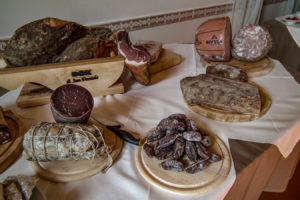
Salami of all sorts was included in the display

A selection of cheeses and salamis served all week
Tuscan bread is without salt to balance the saltiness of meats and cheese. Lard is a staple for fats. Lard, fava beans and pecorino “salad” is an Easter specialty in the region. Dried vegetables (think dehydrators) make great flours for pasta and breads. We ate an amazing spinach roll with our dinner which used dried spinach in place of half the flour in the recipe. The Etruscan cave drawings show them making rolled “picci” noodles which are the fattest on the spaghetti spectrum.
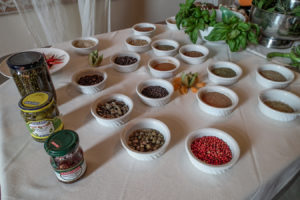
Spices in abundance – most grown locally
Traditional lasagna does not use ricotta – use noodles, Bolognese, parmesana, and béchamel layers. The best flour for noodle making now comes from Iowa called Manitoba flour. Italians import it from Barilla’s plant in the US.
Whew! And we took a short break before moving into the kitchen.

